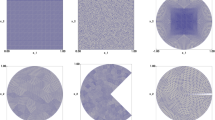Abstract
We investigate an inverse problem of identifying a Robin coefficient with a sparse structure in the Laplace equation from noisy boundary measurements. The sparse structure of the Robin coefficient γ is understood as a small perturbation of a reference profile γ 0 in the sense that their difference γ−γ 0 has a small support. This problem is formulated as an optimal control problem with an L 1-regularization term. An iteratively reweighted least-squares algorithm with an inner semismooth Newton iteration is employed to solve the resulting optimization problem, and the convergence of the iteratively weighted least-squares algorithm is established. Numerical results for two-dimensional problems are presented to illustrate the efficiency of the proposed method.
Similar content being viewed by others
References
Adams, R.A., Fournier, J.J.F.: Sobolev Spaces, 2nd edn. Elsevier/Academic Press, Amsterdam (2003)
Belgacem, F.B.: Why is the Cauchy problem severely ill-posed. Inverse Probl. 23(2), 823–836 (2007)
Bissantz, N., Dümbgen, L., Munk, A., Stratmann, B.: Convergence analysis of generalized iteratively reweighted least squares algorithms on convex function spaces. SIAM J. Optim. 19(4), 1828–1845 (2008)
Bonesky, T., Bredies, K., Lorenz, D.A., Maass, P.: A generalized conditional gradient method for nonlinear operator equations with sparsity constraints. Inverse Probl. 23(5), 2041–2058 (2007)
Casas, E., Clason, C., Kunisch, K.: Parabolic control problems in measure spaces with sparse solutions. SIAM J. Control. Optim. 51(1), 28–63 (2013)
Chaabane, S., Feki, I., Mars, N.: Numerical reconstruction of a piecewise constant Robin parameter in the two- or three-dimensional case. Inverse Probl. 28(6), 065016, 19 (2012)
Clason, C., Kunisch, K.: A duality-based approach to elliptic control problems in non-reflexive Banach spaces. ESAIM Control. Optim. Calc. Var. 17(1), 243–266 (2011)
Dacorogna, B.: Weak continuity and weak lower semicontinuity of nonlinear functionals. In: Lecture Notes in Mathematics, vol. 922. Springer-Verlag, Berlin (1982)
Daubechies, I., Defrise, M., De Mol, C.: An iterative thresholding algorithm for linear inverse problems with a sparsity constraint. Comm. Pure Appl. Math. 57(11), 1413–1457 (2004)
Daubechies, I., DeVore, R., Fornasier, M., Güntürk, C.S.: Iteratively reweighted least squares minimization for sparse recovery. Comm. Pure Appl. Math. 63(1), 1–38 (2010)
Fang, W., Cumberbatch, E.: Inverse problems for metal oxide semiconductor field-effect transistor contact resistivity. SIAM J. Appl. Math. 52(3), 699–709 (1992)
Fang, W., Lu, M.: A fast collocation method for an inverse boundary value problem. Int. J. Numer. Methods Eng. 59(12), 1563–1585 (2004)
Fasino, D., Inglese, G.: An inverse Robin problem for Laplace’s equation: theoretical results and numerical methods. Inverse Probl. 15(1), 41–48 (1999)
Geng, J., Shen, Z.: The Neumann problem and Helmholtz decomposition in convex domains. J. Funct. Anal. 259(8), 2147–2164 (2010)
Green, P.J.: Iteratively reweighted least squares for maximum likelihood estimation, and some robust and resistant alternatives. J. Roy. Statist. Soc. Ser. B. 46(2), 149–192 (1984). With discussion
Griesse, R., Lorenz, D.A.: A semismooth Newton method for Tikhonov functionals with sparsity constraints. Inverse Probl. 24(3), 035007, 19 (2008)
Hintermüller, M., Ito, K., Kunisch, K.: The primal-dual active set strategy as a semismooth Newton method. SIAM J. Optim. 13(3), 865–888 (2002)
Inglese, G.: An inverse problem in corrosion detection. Inverse Probl. 13(4), 977–994 (1997)
Isakov, V.: Inverse Problems for Partial Differential Equations. Springer-Verlag, New York (1998)
Ito, K., Kunisch, K.: Lagrange Multiplier Approach to Variational Problems and Applications. SIAM, Philadelphia (2008)
Jerison, D., Kenig, C.E.: The inhomogeneous Dirichlet problem in Lipschitz domains. J. Funct. Anal. 130(1), 161–219 (1995)
Jin, B., Maass, P.: Sparsity regularization for parameter identification problems. Inverse Probl. 28(12), 123001, 70 (2012)
Jin, B., Zou, J.: Numerical estimation of piecewise constant Robin coefficient. SIAM J. Control Optim. 48(3), 1977–2002 (2009)
Jin, B., Zou, J.: Numerical estimation of the Robin coefficient in a stationary diffusion equation. IMA J. Numer. Anal. 30(3), 677–701 (2010)
Kreith, F. (Ed): The CRC Handbook of Thermal Engineering. CRC, Bota Raton (2000)
Lai, M.-J., Xu, Y., Yin, W.: Improved iteratively reweighted least squares for unconstrained smoothed ℓ q minimization. SIAM J. Numer. Anal. 51(2), 927–957 (2013)
Lin, F., Fang, W.: A linear integral equation approach to the Robin inverse problem. Inverse Probl. 21(5), 1757–1772 (2005)
Stadler, G.: Elliptic optimal control problems with L 1-control cost applications for the placement of control devices. Comput. Optim. Appl. 44(2), 159–181 (2009)
Wolke, R., Schwetlick, H.: Iteratively reweighted least squares: algorithms, convergence analysis, and numerical comparisons. SIAM J. Sci. Statist. Comput. 9(5), 907–921 (1988)
Author information
Authors and Affiliations
Corresponding author
Additional information
Communicated by: Y. Xu
Rights and permissions
About this article
Cite this article
Sun, Z., Jiao, Y., Jin, B. et al. Numerical identification of a sparse Robin coefficient. Adv Comput Math 41, 131–148 (2015). https://doi.org/10.1007/s10444-014-9352-5
Received:
Accepted:
Published:
Issue Date:
DOI: https://doi.org/10.1007/s10444-014-9352-5
Keywords
- Inverse Robin problem
- Sparsity regularization
- Iteratively reweighted least squares method
- Semismooth Newton method




